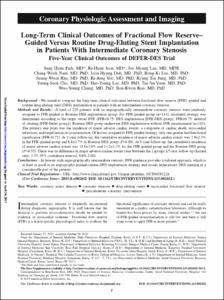KUMEL Repository
1. Journal Papers (연구논문)
1. School of Medicine (의과대학)
Dept. of Internal Medicine (내과학)
Long-Term Clinical Outcomes of Fractional Flow Reserve-Guided Versus Routine Drug-Eluting Stent Implantation in Patients With Intermediate Coronary Stenosis: Five-Year Clinical Outcomes of DEFER-DES Trial.
- Affiliated Author(s)
- 남창욱
- Alternative Author(s)
- Nam, Chang Wook
- Journal Title
- Circulation: Cardiovascular Interventions.
- ISSN
- 1941-7640
- Issued Date
- 2015
- Keyword
- Coronary artery disease; Coronary stenosis; Drug-eluting stents; Myocardial fractional flow reserve; Percutaneous coronary intervention
- Abstract
- Background—We aimed to compare the long-term clinical outcomes between fractional flow reserve (FFR)–guided and
routine drug-eluting stent (DES) implantation in patients with an intermediate coronary stenosis.
Methods and Results—A total of 229 patients with an angiographically intermediate coronary stenosis were randomly
assigned to FFR-guided or Routine-DES implantation group. For FFR-guided group (n=114), treatment strategy was
determined according to the target vessel FFR (FFR<0.75: DES implantation [FFR-DES group]; FFR≥0.75: deferral
of stenting [FFR-Defer group]). Routine-DES group underwent DES implantation without FFR measurement (n=115).
The primary end point was the incidence of major adverse cardiac events, a composite of cardiac death, myocardial
infarction, and target lesion revascularization. Of lesions assigned to FFR-guided strategy, only one quarter had functional
significance (FFR<0.75). At 2-year follow-up, the cumulative incidence of major adverse cardiac events was 7.9±2.5%
in the FFR-guided group and 8.8±2.7% in Routine-DES group (P=0.80). At 5-year follow-up, the cumulative incidence
of major adverse cardiac events was 11.6±3.0% and 14.2±3.3% for the FFR-guided group and the Routine-DES group
(P=0.55). There was no difference in major adverse cardiac events rates between the 2 groups ≤5-year follow-up (hazard
ratio, 1.25; 95% confidence interval, 0.60–2.60).
Conclusions—In lesions with angiographically intermediate stenosis, FFR guidance provides a tailored approach, which is
at least as good as an angiography-guided routine-DES implantation strategy and avoids unnecessary DES-stenting in a
considerable part of the patients.
- Department
- Dept. of Internal Medicine (내과학)
- Publisher
- School of Medicine
- Citation
- Sang Hyun Park et al. (2015). Long-Term Clinical Outcomes of Fractional Flow Reserve-Guided Versus Routine Drug-Eluting Stent Implantation in Patients With Intermediate Coronary Stenosis: Five-Year Clinical Outcomes of DEFER-DES Trial. Circulation: Cardiovascular Interventions., 8(12), e002442–e002442. doi: 10.1161/CIRCINTERVENTIONS.115.002442
- Type
- Article
- ISSN
- 1941-7640
- Appears in Collections:
- 1. School of Medicine (의과대학) > Dept. of Internal Medicine (내과학)
- 파일 목록
-
-
Download
 oak-2015-0140.pdf
기타 데이터 / 1.13 MB / Adobe PDF
oak-2015-0140.pdf
기타 데이터 / 1.13 MB / Adobe PDF
-
Items in Repository are protected by copyright, with all rights reserved, unless otherwise indicated.